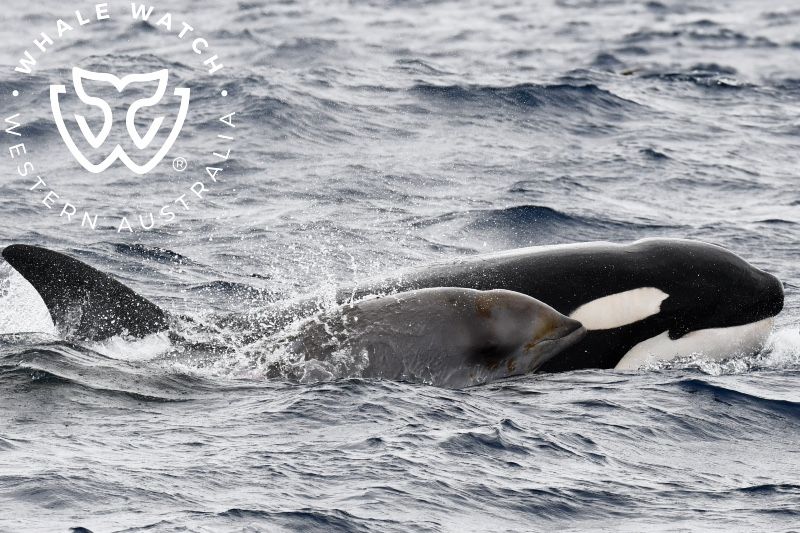Orca populations around the world have been well-documented as apex predators with diverse feeding habits, varying with geographical location, prey availability, and distinct cultural behaviours. The orca population in Western Australia, particularly in the Bremer Canyon region, exhibits unique feeding behaviours that capture the attention of both marine biologists and wildlife enthusiasts alike.
Hunting in the Biodiversity Patch
The Bremer Canyon area is a biodiversity location, creating a vast range of marine life due to nutrient upwelling events that occur annually from January to April [1]. Orcas, also known as killer whales, migrate to this region during these months, transforming the area into a dynamic hunting ground. The diverse prey available in the region supports the unique feeding habits of these orcas, contributing to an enthralling spectacle of nature.
Predatory Techniques and Prey Selection
Orcas in the Bremer Bay region demonstrate an extensive diet. These apex predators have been observed feeding on a range of species, from fish and squid to larger marine mammals [2]. While fish and squid are common in the diets of orcas worldwide, the Western Australian orcas have exhibited an intriguing predatory behaviour towards a particularly elusive prey – the beaked whale.
The beaked whale, a deep-diving species, is notoriously difficult to study due to its elusive behaviour and remote habitats [3]. The observed predation by orcas in Western Australia offers a unique glimpse into the interactions between these two species. Notably, such feeding behaviour involving beaked whales is infrequently documented, making the observations in Western Australia exceptionally noteworthy.

Implications for Orca Behaviour and Ecology
The complex hunting strategies and choice of prey seen in the orcas of Western Australia speak volumes about their adaptability and intelligence. Their behaviour underscores the rich biodiversity of the Bremer Canyon region, emphasizing its significance as an ecological patch[4].
The predation of beaked whales highlights an interesting aspect of the orca’s ecological role. Orcas are one of the few predators of these elusive cetaceans, pointing towards their ecological role in maintaining the balance in the marine ecosystem. More research is required to understand the full extent of this relationship and its implications for both species’ conservation efforts.
https://www.youtube.com/watch?v=vHChQrEGbJg&t=44s
Concluding Remarks
The feeding habits of orcas in Western Australia provide valuable insights into the behaviour, adaptability, and ecological roles of these apex predators. The region’s unique ecological conditions, coupled with the orca’s diverse diet, underscore the importance of protecting these marine environments for the preservation of such dynamic predator-prey interactions. As we continue to study these fascinating creatures, it is essential to ensure that our activities, from tourism to fishing, do not disturb their natural behaviour or their critical role in the ecosystem.
References:
^1^ Wellard, R., Fouda, L., BlewiC, D., & Erbe, C. (2016). Killer Whale (Orcinus orca) Predation on Beaked Whales (Mesoplodon spp.) in the Bremer Sub-Basin, Western Australia. PLoS ONE, 11(12), e0166670. hCps://doi.org/10.1371/journal.pone.0166670
^2^ Pitman, R.L., Durban, J.W., Greenfelder, M., Guinet, C., Jorgensen, M., Olson, P.A., Plana, J., Tixier, P. and Towers, J.R. (2011). Observations of a distinctive morphotype of killer whale (Orcinus orca), type D, from subantarctic waters. Polar Biology
^3^ Hooker, S.K., & Baird, R.W. (1999). Deep-diving behaviour of the northern boClenose whale, Hyperoodon ampullatus (Cetacea: Ziphiidae). Proceedings of the Royal Society of London. Series B: Biological Sciences, 266(1433), 671–676. hCps://doi.org/10.1098/rspb.1999.0688
^4^ Wellard, R., Erbe, C., Fouda, L., & BlewiC, M. (2015). Vocalisations of Killer Whales (Orcinus orca) in the Bremer Canyon, Western Australia. PLoS ONE, 10(9), e0136535. hCps://doi.org/10.1371/ journal.pone.0136535






